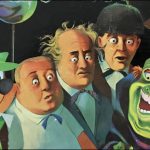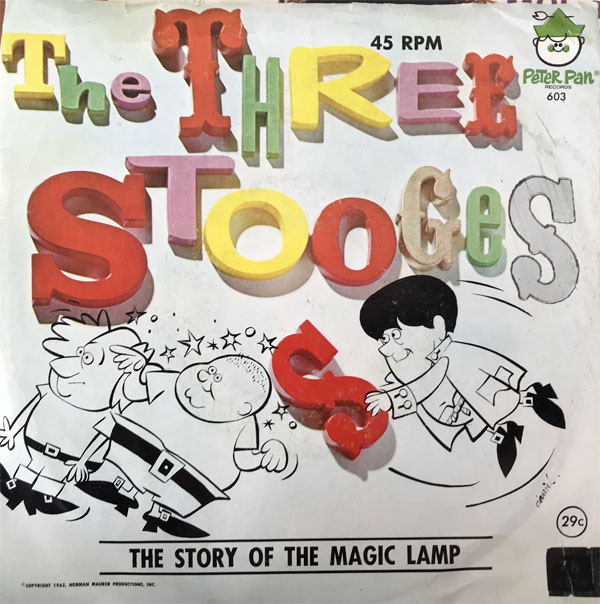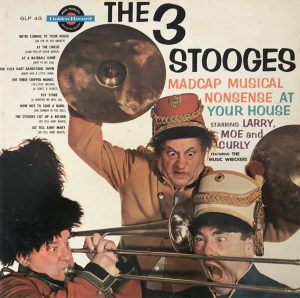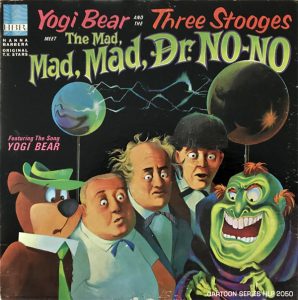The Three Stooges in “Record Smashes & Cartoon Crashes”


 This rebirth was not lost on the remaining Stooges, nor their families and associates. Norman Maurer, who married the lovely Joan Howard (daughter of Moe) in 1947, was responsible for comic books starring the Stooges, as well as an additional comic line with “Little Stooges” (before Muppet Babies and Tiny Toon Adventures). Maurer became a business partner and developed new projects featuring images of the most famous three, in addition to the then-current team of Moe Howard, Larry Fine, and Curly Joe DeRita. In the fifties, they became a welcome presence on such variety shows as Texaco Star Theater, The Frank Sinatra Show, The Colgate Comedy Hour, and The Steve Allen Show.
This rebirth was not lost on the remaining Stooges, nor their families and associates. Norman Maurer, who married the lovely Joan Howard (daughter of Moe) in 1947, was responsible for comic books starring the Stooges, as well as an additional comic line with “Little Stooges” (before Muppet Babies and Tiny Toon Adventures). Maurer became a business partner and developed new projects featuring images of the most famous three, in addition to the then-current team of Moe Howard, Larry Fine, and Curly Joe DeRita. In the fifties, they became a welcome presence on such variety shows as Texaco Star Theater, The Frank Sinatra Show, The Colgate Comedy Hour, and The Steve Allen Show.
According to The Three Stooges Scrapbook by Joan Howard Maurer, Jeff Lenburg, and Greg Lenburg, the first attempt at a TV series, at least in the talking stages, was pitched by friends of Shemp Howard. We Wuz There spoofed Walter Cronkite’s You Are There with the Stooges appearing in humorous looks at history.
With Moe as Vice-President, Maurer formed Illustrated Films in 1958 for a Stooge Time TV series combining live segments with cartoons using the “Artiscope” process, described as “a revolutionary automated animation system that filmed ‘live’ actors and utilized an optical-chemical process to transform each frame of the film into line drawings that looked like they were hand-drawn.” Edward Bernds was to direct the live-action and Friz Freleng would direct the cartoon sequences. Even though an Artiscope test film was produced in 1954 called Captain Lafitte with Don Lomond and Moe, it did not sell.
1959’s Three Stooges Scrapbook did make it to the pilot stage. The premise placed the live-action trio in a creepy old house (in Lompoc, California), where a mad scientist (favorite Stooge co-star Emile Sitka) invents an extraordinary vehicle, enabling animated Stooges to, as proposed earlier, journey through history. The Stooges and Maurer formed Normandy Productions and hired TV Spots (Crusader Rabbit) for the cartoon. The live-action segment is available on YouTube.
Three Stooges Scrapbook was not picked up, but the footage from the pilot was reused for the Stooges’ 1962 feature, The Three Stooges in Orbit.
The late fifties and early sixties became a haven for family-friendly comedies, particularly Walt Disney’s The Shaggy Dog, itself originally turned down by ABC for a TV series yet such a smash on the big screen it surpassed Sleeping Beauty at the box office. The first feature-length film starring The Three Stooges (with the exception of 1930’s Soup to Nuts with Ted Healy), was Have Rocket, Will Travel, featuring a less violent Howard, Fine, and DeRita in a zany space send-up. Colpix Records released a single of the film’s theme song, sung by the Stooges in the film.
This is a personalized “Happy Birthday” record sold by “Normy Enterprises” that features the Stooges singing and joking while mentioning a specific child’s name. A popular gimmick, this was also done on recordings by Captain Kangaroo, Popeye, Mickey Mouse, and friends and others. This video is an edited version with some interesting promotional materials that tie into the Stooges’ TV fame:
Here is a full version of the record for birthday boy “Johnny:”
Their first long-playing album was also their most elaborate. Coral/Decca’s The Three Stooges: The Nonsense Songbook gave the world fully orchestrated renditions of favorite novelty tunes in stereo. For Warner cartoon and Roger Rabbit fans, there’s “The Merry-Go-Round Broke Down,” and for Stooge and Charley Chase enthusiasts, they sing their beloved “Swinging the Alphabet” from 1938’s Violent is the Word for Curly. The album was in print and reissued for years, later released on CD.
Golden Records released a 45 rpm EP in 1959 (the same year the Three Stooges Scrapbook pilot was being pitched). Six Happy Yuletide Songs, reissued by Rhino as Christmas Time with The Three Stooges. Columbia Records presented the trio in a 1961 soundtrack story album based on the most expensive Stooge feature, 1961’s Snow White and the Three Stooges. This LP was explored in an earlier Animation Spin devoted to Snow White records.
1962 brought two more features, The Three Stooges Meet Hercules and The Three Stooges in Orbit, and another album. Golden Records released the most modular of their LP, Madcap Musical Nonsense. It was written by Bill Buchanan and Dick Cella, who were also responsible for another Golden bestseller, The Golden Treasury of Great Bedtime Story-Songs, reissued as Bedtime Stories. This album, which was reissued to the grownup nostalgia market by Rhino Records, is a collection of parodies to public domain children’s songs and short sketches. The sections of the album were divided into parts so the segments could also be sold as Little Golden Records and Golden 3-on-1 EP Records.
The various incarnations and attempts at animated Three Stooges TV shows are most evident on the Peter Pan LP, A Rocket Ship Ride Through Time and Space to Storyland. It was released in 1963 (the same year they starred in The Three Stooges Go Around the World in a Daze and appeared in Four for Texas and It’s a Mad, Mad, Mad, Mad World). As the lengthy title of the Peter Pan LP states, the Stooges rocket to the “once upon a times” of several fairy tales. The LP and 45 rpm versions of this production featured cartoon renderings of the Stooges. When Peter Pan reissued it in 1973 as The Three Stooges and Six Funny Bone Stories, the cover art (by Bill Peet’s brother George Peed) depicted them in caricature.
Here is the first portion of the Peter Pan album, in which the Stooges board the rocket ship:
The album continues here in which they meet Cinderella, then the Ugly Duckling, the Princess and the Pea, and find the Magic Lamp.
1965 marked the premiere of the syndicated TV series, The New Three Stooges, produced by Cambria Studios (Clutch Cargo). Each cartoon opened and closed with color live-action segments. This series enjoyed a long life, as the five-minute episodes were easily placed where needed by local stations. It was also released in a DVD set. Their final feature was also in theaters that year: The Outlaws IS Coming.
Perhaps the most bizarre and beguiling album comes from Hanna-Barbera Records in 1966: the gloriously goofy Yogi Bear and the Three Stooges Meet the Mad, Mad, Mad Dr. No-No. The authors of The Three Stooges Scrapbook called it “a well-deserved success.”
 In addition to the voices of Moe, Larry, and Curly Joe, Daws Butler plays Yogi, the rangers, Dr. No-No (Uncle to Dr. No), and his “stooge,” Fang. This is the only Hanna-Barbera Cartoon Series album upon which Butler voiced Yogi (though he recorded others that were never released and they are revealed in this keen book). The disc is also a banquet of great music cues from The Yogi Bear Show, The Flintstones, The Jetsons, Jonny Quest, The Magilla Gorilla Show, and Loopy DeLoop cartoons.
In addition to the voices of Moe, Larry, and Curly Joe, Daws Butler plays Yogi, the rangers, Dr. No-No (Uncle to Dr. No), and his “stooge,” Fang. This is the only Hanna-Barbera Cartoon Series album upon which Butler voiced Yogi (though he recorded others that were never released and they are revealed in this keen book). The disc is also a banquet of great music cues from The Yogi Bear Show, The Flintstones, The Jetsons, Jonny Quest, The Magilla Gorilla Show, and Loopy DeLoop cartoons.
The story finds Yogi such a popular public attraction, that LBJ sends an order to the rangers from Washington to keep Yogi from constantly escaping from Jellystone Park. The Park Department’s “three best rangers” are assigned to keep track of Yogi. Of course, Yogi slips away, dressed as a lady, but it backfires as he finds himself caught in a storm. (In the absence of Boo-Boo, Yogi talks to himself about his predicament, the same way José Jiminez does on the HBR LP The Flintstones and José Jiminez in The Time Machine.)
In the tradition of classic comedy horror movies and TV shows (as well as The Rocky Horror Picture Show), Yogi discovers a classic creepy old house where he can seek shelter. HBR fans will notice that Daws Butler’s voices for Dr. No-No and Fang are similar to the ones he used for Dr. Oh-No and Killer on Super Snooper’s James Bomb album (love those HBR inside threads!). What follows is the sitcom staple of electronic mental and/or physical transference—a trusty comedy plot that worked for everything from The Flintstones and Gilligan’s Island to The Fly and the Stitch’s Great Escape attraction. The Stooges track Yogi to the mad doctor’s laboratory, where hilarity ensues. Here’s the album to savor like a fine vintage wine:
